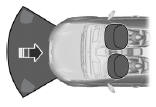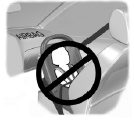WARNING:
Never place your arm or any objects over an airbag module. Placing your arm over a deploying airbag can result in serious arm fractures or other injuries. Objects placed on or over the airbag inflation area may cause those objects to be propelled by the airbag into your face and torso causing serious injury.
WARNING:
Airbags can kill or injure a child in a child seat.
Never place a rear-facing child seat in front of an active airbag.
If you must use a forward-facing child seat in the front seat, move the seat upon which the child seat is installed all the way back.

The driver and front passenger airbags will deploy during significant frontal and near-frontal crashes.
The driver and passenger front airbag system consists of: • Driver and passenger airbag modules.

• Crash sensors and monitoring system with readiness indicator. See Crash Sensors and Airbag Indicator later in this chapter.
• Front passenger sensing system.
Proper Driver and Front Passenger Seating Adjustment
WARNING:
The National Highway Traffic Safety Administration recommends a minimum distance of at least 10 inches (25 centimeters) between an occupant’s chest and the driver airbag module. Failure to follow this could seriously increase the risk of injury or death.
To properly position yourself away from the airbag: • Move your seat to the rear as far as you can while still reaching the pedals comfortably.
• Recline the seat slightly (one or two degrees) from the upright position.
After all occupants have adjusted their seats and put on safety belts, it is very important that they continue to sit properly. Properly seated occupants sit upright, lean against the seat back, and center themselves on the seat cushion, with their feet comfortably extended on the floor.
Sitting improperly can increase the chance of injury in a crash event. For example, if an occupant slouches, lies down, turns sideways, sits forward, leans forward or sideways, or puts one or both feet up, the chance of injury during a crash is greatly increased.
Children and Airbags
WARNING:
Airbags can kill or injure a child in a child seat.
Never place a rear-facing child seat in front of an active airbag.
If you must use a forward-facing child seat in the front seat, move the seat upon which the child seat is installed all the way back.

Children must always be properly restrained. Accident statistics suggest that children are safer when properly restrained in the rear seating positions than in the front seating position. Failure to follow these instructions may increase the risk of injury in a crash.
 Supplementary Restraints System
Supplementary Restraints System
PRINCIPLES OF OPERATION
WARNING: Airbags do not inflate slowly or gently, and the risk
of injury from a deploying airbag is the greatest close to the trim
covering the airbag module.
WARNING: All ...
 Front passenger sensing system
Front passenger sensing system
WARNING: Even with Advanced Restraints Systems, children 12
and under should be properly restrained in a rear seating
position. Failure to follow this could seriously increase the risk of injury
or ...
Other materials:
General Procedures
Sectioning Guidelines
General Equipment
Material
NOTE: The following illustration provides recommended sectioning
points. Cut lines shown in illustration are approximate.
WARNING:
Collision damage repair must conform to the instructions contained in this
workshop manual. Replacement ...
General Procedures
Air Conditioning (A/C) Clutch Air Gap Adjustment
Check the A/C clutch air gap at 3 equally spaced places between the
clutch plate and the A/C clutch pulley.
Remove the clutch plate. Add or remove spacers between the clutch plate
hub and the compressor shaft until the clearance is within ...
Trailer towing
WARNING: Do not exceed the GVWR or the GAWR specified on
the certification label.
WARNING: Towing trailers beyond the maximum recommended
gross trailer weight exceeds the limit of your vehicle and could
result in engine damage, transmission damage, structural damage, loss
of vehicle control, ve ...
